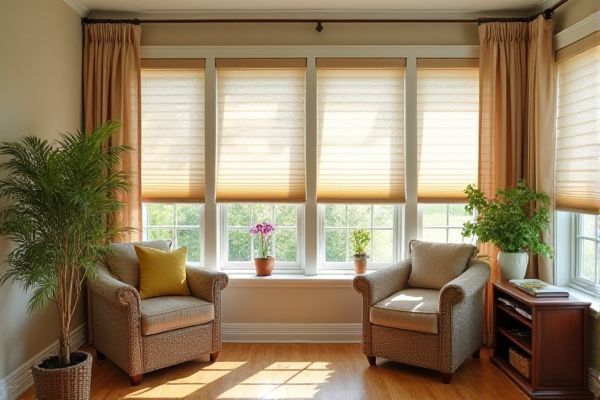
Blinds offer adjustable light control and privacy, making them ideal for sunrooms where sunlight intensity varies throughout the day. Explore the rest of this article to find out which option best suits your sunroom's style and functionality.
Table of Comparison
| Feature | Blinds | Curtains |
|---|---|---|
| Light Control | Adjustable slats allow precise light regulation | Fabric panels offer variable light blockage based on thickness |
| Privacy | High privacy with adjustable slats | Good privacy, depends on fabric opacity |
| Durability | Resistant to sun damage, easy to clean | May fade or weaken in direct sun, requires washing |
| Insulation | Limited insulation, reduces glare | Better thermal insulation, retains heat |
| Appearance | Modern, sleek look | Soft, decorative, classic style |
| Maintenance | Simple wipe-clean maintenance | Requires regular washing or dry cleaning |
| Cost | Generally more affordable | Varies, often higher depending on fabric |
| Installation | Easy to install, fits window frames | Requires curtain rods and mounting hardware |
Introduction to Sunroom Window Treatments
Sunroom window treatments enhance comfort and control sunlight while preserving outdoor views. Blinds offer adjustable light filtration and privacy with sleek, versatile designs ideal for sunrooms. Curtains provide softness and insulation, available in various fabrics that complement sunroom aesthetics and protect furniture from UV damage.
Key Differences: Blinds vs Curtains
Blinds in sunrooms offer precise light control and privacy with adjustable slats, while curtains provide a softer aesthetic and full fabric coverage for insulation and style. Blinds are typically more space-efficient and easier to clean, whereas curtains enhance warmth and can be easily swapped for seasonal decor changes. Choosing between blinds and curtains depends on the desired balance of light management, insulation, maintenance, and interior design preferences.
Light Control and Privacy
Blinds offer precise light control in a sunroom by allowing adjustable slats to regulate sunlight intensity and direction, enhancing privacy while maintaining visibility. Curtains provide a softer, diffused light effect and can be fully drawn to block external views, ensuring maximum privacy. Choosing between blinds and curtains depends on the balance desired between adjustable illumination and aesthetic privacy needs.
Energy Efficiency and Insulation
Blinds in sunrooms offer precise light control and can effectively reduce heat gain during hot months, enhancing energy efficiency by minimizing the need for air conditioning. Curtains, particularly those made with thermal or insulated fabrics, provide superior insulation by trapping heat during colder months, which helps maintain a consistent indoor temperature and lowers heating costs. Selecting the right window treatment based on seasonal energy needs can optimize insulation and contribute to overall energy savings in sunroom spaces.
Style and Aesthetic Appeal
Blinds in sunrooms offer a sleek, modern aesthetic with clean lines that complement contemporary design and maximize light control. Curtains provide a softer, more traditional look, adding texture and warmth through various fabrics and patterns that enhance cozy or classic styles. Choosing between blinds and curtains depends on desired ambiance; blinds emphasize minimalism and structure, while curtains contribute to a relaxed, inviting atmosphere.
Maintenance and Durability
Blinds in sunrooms offer easier maintenance with dusting or wiping, and their materials like aluminum or faux wood resist moisture and UV damage, enhancing durability. Curtains require regular washing to prevent dust buildup and can fade or deteriorate faster due to sun exposure and humidity. Choosing moisture-resistant blinds improves longevity and reduces upkeep compared to fabric curtains in sunroom environments.
Cost Comparison
Blinds for sunrooms typically range from $50 to $200 per window, offering a budget-friendly option with customizable styles and light control. Curtains, depending on fabric quality and design, can cost between $100 and $400 per window, often requiring additional hardware purchases. Overall, blinds provide a more cost-effective solution for sunroom window treatments, especially when factoring in durability and maintenance expenses.
Installation and Customization Options
Blinds in a sunroom offer straightforward installation with options such as inside or outside mount frames tailored to window dimensions, providing precise light control and privacy. Curtains provide versatile customization with a range of fabrics, patterns, and rod styles, allowing adjustments in length, fullness, and layering to suit both energy efficiency and aesthetic preferences. Both options accommodate motorized systems and smart home integration for enhanced convenience and automation.
Best Materials for Sunroom Conditions
Sunrooms demand window treatments made from materials that withstand high sunlight exposure and temperature fluctuations; aluminum blinds resist warping and fading while providing adjustable light control. Polyester curtains offer durability, fade resistance, and easy maintenance suitable for humid environments common in sunrooms. Both options benefit from UV-protective coatings to enhance longevity and preserve indoor comfort.
Choosing the Right Option for Your Sunroom
Blinds offer adjustable light control and privacy, making them ideal for sunrooms that receive varying sunlight throughout the day. Curtains provide a softer aesthetic and better insulation, enhancing comfort and style in cooler months. Your choice depends on whether you prioritize light management with blinds or the cozy ambiance of curtains.
 homyna.com
homyna.com